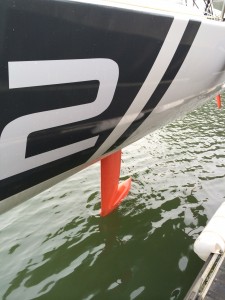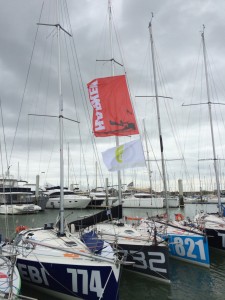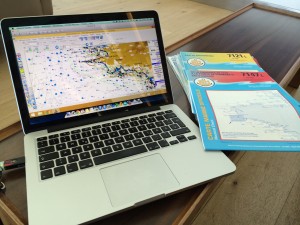Delivery for the season’s first race
 Having spent two days in Paris for business I finally made my way to Lorient on thursday night. Although I had to work on friday I still managed to pick up the new Code 0 from Incidences and the remote for the autopilot from nke.
Having spent two days in Paris for business I finally made my way to Lorient on thursday night. Although I had to work on friday I still managed to pick up the new Code 0 from Incidences and the remote for the autopilot from nke.
Friday after work things started to get busy for me as I had to get the boat ready to deliver it to Pornichet this weekend.
Between me and my departure were a couple of todos (copied from my todo list):
– fit & install new rudders
– inspect and install rudder / tillers
– remove old stickers from boat, apply new ones
– wash the deck
– drill and prepare spare “V” for the bowsprit
– sew new markings into the main halyard for the different reefs
– attach reflective stickers to the liferaft
– install liferaft
– put the boat into the water
– install nke windvane at top of mast
– check rigg / tighten screws at the spreaders
– change bungee cord for the backstays
– install boom & all lines
– attach main sail
All of this was finally done on saturday night around 7pm which was the first time I checked the weather forecast for my delivery. For that night there were 5 to 15kt from S to SW forecasted, on sunday it would be the same direction albeit 20-25kt.
I wasn’t looking forward to a windy first delivery so I decided to spontaneously leave rightaway while there was still a bit of light left.
After a quick bite I was already short-tacking my way out of Lorient and heading into the night.
Once out of the bay of Lorient I was able to just lay Île de Quiberon and took some naps.
Île de Quiberon appeared to me only as an orange haze as it was extremely misty with poor visibility of about 1/2nm.
Around me the boats that were sailing the “Lorient Bretagne Sud Mini” race appeared – they had already rounded Belle Île and Île de Groix and were now on the way to Pornichet as well.
Now we were able to bear away a bit after every island we passed and it became a nice reach.
I did not hoist my code 0 and stayed outside the field to not mess with the guys in the race.
 When we finally rounded the cardinal buoy “Goue vas du Four” and headed into the bay of pornichet I hoisted the medium kite (reefed, again not to interfere with the race) and we trucked along nicely with 7-8 knots, being able to stick to the boats that were racing.
When we finally rounded the cardinal buoy “Goue vas du Four” and headed into the bay of pornichet I hoisted the medium kite (reefed, again not to interfere with the race) and we trucked along nicely with 7-8 knots, being able to stick to the boats that were racing.
In the morning haze I finally arrived in Pornichet causing a bit of confusion as the committee assumed I had finished the race in 18th place (ooops – although I announced that I was on “convoyage”) and was finally moored in the marina at abou6 6:30am.
That’s a 6kt average – not bad.
Now a week in Pornichet with race prep / security checks and working before the first race of the season begins on saturday: the Pornichet Select 6.50
Navigation prep brouhaha
Since the last two weeks were swamped with work (read day job work) there was hardly any time left to prepare things for the boat in the evenings.
So I decided it’s time for my first brouhaha with the topic “navigation prep”.
The goal for the end of the week is:
1) to have all important landmarks, buoys, etc. marked as waypoints in Adrena
2) creating draft routes for the races to come
3) creating routes for narrows (e.g. between Hoedic/Houat/Ile de Quiberon) and to write down the maximum allowed cross track error (so that I can tack through those narrows)
4) exporting all waypoints so that I can print them lateron to have as a backup on board
5) putting all important waypoints into the paper charts with their 6-letter code (my Furuno GPS only allows waypoint names of maximum 6 characters)
6) preparing a rough roadbook for each race so it’s less work the last days before each race.
 Now I had to leave for a one week business trip to the US on a bit of a short notice but I decided that that won’t stop me. I tool all (!) my paper charts with me and will do the navigation prep for the races on the atlantic coast and the qualifier while on the road. Every minute counts will be my motto for the weeks to come.
Now I had to leave for a one week business trip to the US on a bit of a short notice but I decided that that won’t stop me. I tool all (!) my paper charts with me and will do the navigation prep for the races on the atlantic coast and the qualifier while on the road. Every minute counts will be my motto for the weeks to come.
By the way, all the waypoints will be uploaded from the laptop to the gps later when I’m back on board.
The photo shows how I repurposed parts of the BA Lounge in Heathrow to my personal navigation prep room.
Of sprints and brouhahas
In my job as a software developer we organize our work following the “Scrum” model for agile software development.
That is a methodology where the work is split up in “sprints” that have a fixed length (e.g. 4 weeks). At the end of each sprint there should be a piece of software that is runnable (i.e. works).
That is different from the classic approach where one defined a set of requirements that had to be implemented which were then organized in a long and very detailed planning phase which was then followed by an very long and often delayed implementation phase.
By using sprints the risk of missing the mark and/or the deadline is highly reduced. One can react quicker to changing parameters (e.g. available time/resources) and still end up with a usable product that might have less features than originally planned but is ready at a predetermined time.
As I looked at the list of open todos that need to be done (some of them need to be ready by April 13th for the Select 6.50, others for the Acores race in july) I realized how much that resembled a software development project.
The target “product” is the combination of a race-ready boat and a well prepared skipper.
So I decided to treat my preparation as an agile project now and split the available time into sprints at which end both me and the boat should always be ready to leave for a race immediately.
And that might sound easier than it is considering that my todo list currently spans rigg work (trimming the mast, splicing halyards), electrics (fuse box is messy, fuel cell needs to be installed), electronics (data logger needs to be rewired, collision alert has to be wired) and personal preparation (fitness, meteo).
But this also sounds familiar from my job as a software developer. When working on a software component we often have to juggle different aspects that all have to be worked on more or less in parallel, e.g.: adding new features, fixing bugs, optimizing performance, interface definition, writing documentation, etc.
Now since the effectiveness of your work is considerably lower when you often have to switch from one area to the other we will often add so called “brouhaha”s to our sprints.
A brouhaha is a timespan of 2 to 5 days in which we will focus entirely on a specific area of work, e.g. performance optimization. It is incredible how much progress one can make by focussing on a specific area of work for some days.
So I will adapt this as well to my race preparations and add brouhahas to my sprints where it seems a good fit to finish a certain aspect of race preparation quickly and soundly.
So, sprints and brouhahas will be a frequent topic for weeks and months to come. It’s only 4 1/2 months left till the start of the acores race and until then more than 2000nm will need to be sailed successfully!